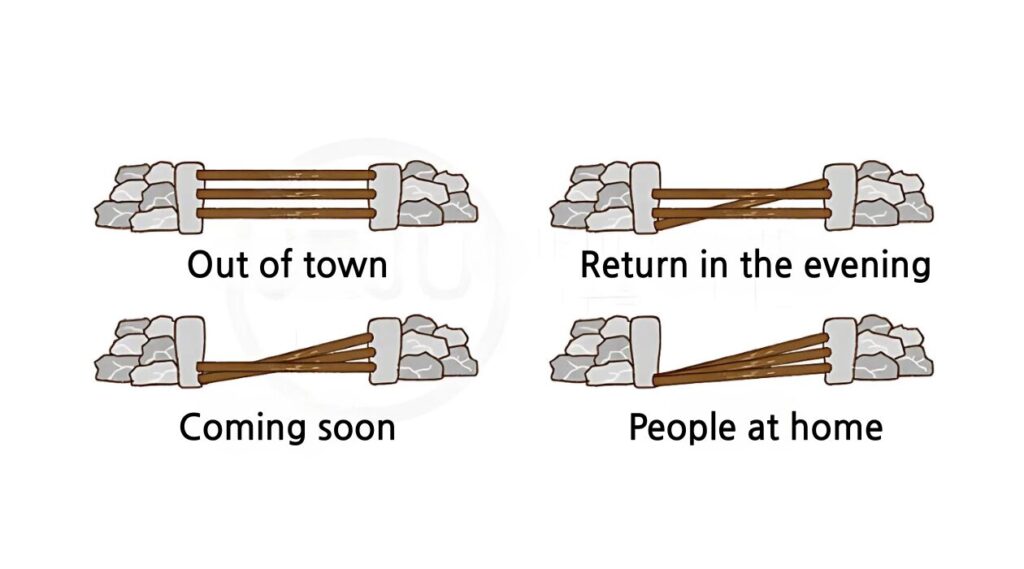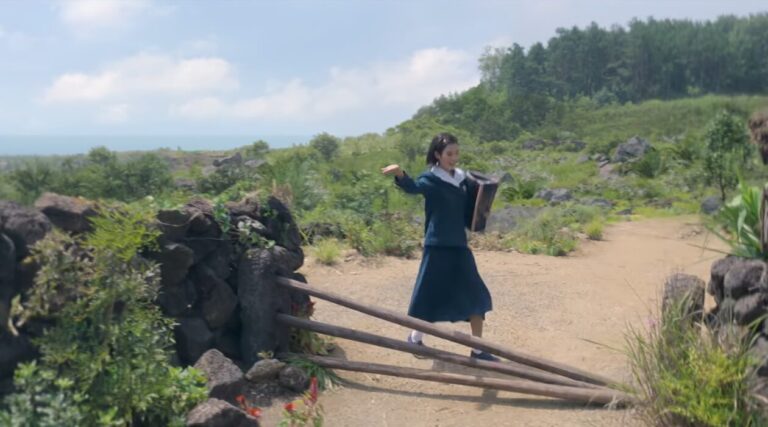Table of Contents:
Have you ever noticed the absence of gates in Jeju houses while watching the Netflix series When Life Gives You Tangerines? Instead of doors, many traditional homes use a set of wooden bars between two stone or wooden pillars. This structure is called Jeongnang, and it’s far more than a gate — it’s a symbol of trust, communication, and community that defines Jeju’s unique cultural heritage.
What Is Jeongnang? Jeju’s Gate Without a Lock
Jeongnang is a traditional entrance structure used in old Jeju homes. It consists of two vertical posts — either stone (Jeongjuseok) or wood (Jeongjumok) — and up to three horizontal wooden bars laid between them.
These wooden bars were used not to physically block entry, but to signal whether the homeowner was present, making it a silent communication system in a tightly-knit rural community.
The Significance of Jeongnang: More Than a Physical Barrier
Unlike typical gates that block access, Jeongnang communicated important information through the number of bars in place.

This system only worked in a society built on trust and mutual respect. It allowed neighbors to make decisions like visiting or helping with livestock based on this simple visual signal.
Livestock Control: A Practical Use of Jeongnang
Jeju’s traditional lifestyle included free-roaming livestock, such as cows and horses. Jeongnang served a secondary purpose: it prevented these animals from entering courtyards and damaging crops.
Instead of tall gates or walls, simple wooden bars kept animals out while maintaining openness — a practical solution reflecting harmony with nature.
Spiritual and Symbolic Role in Korean Folk Beliefs
In Korean folk belief, Jeongnang pillars weren’t just architectural elements. They were often viewed as guardian spirits of the home.
Especially on holidays or special events, locals would offer prayers or food at the Jeongnang to protect the house from evil spirits. This gives Jeongnang a sacred dimension beyond its everyday function.
Jeongnang in Modern Jeju: Preserved and Reimagined
Although modern Jeju homes have adopted conventional gates and fences, Jeongnang still holds a visible and symbolic place in the island’s cultural landscape. It is not a forgotten relic, but a form of living heritage. Today, Jeongnang structures are carefully preserved and presented in sites dedicated to cultural preservation and education.
Jeju Folk Village and Seongeup Folk Village are among the most well-known destinations where visitors can see original or reconstructed Jeongnang installations in authentic settings. These villages recreate the architectural and social atmosphere of historical Jeju, allowing travelers to understand how Jeongnang was integrated into daily life.
In addition, some traditional guesthouses and cultural accommodations on the island choose to recreate Jeongnang at their entrances — not only as decoration, but as a symbolic connection to Jeju’s past. These modern interpretations of Jeongnang reflect a growing interest in cultural identity, sustainability, and minimalist design.
Interestingly, Jeongnang has gained academic and design attention for its function as a communication system. Scholars and designers have likened it to a low-tech predecessor of IoT-based home signaling, where presence and absence are conveyed through visual cues. Its simplicity, clarity, and reliance on mutual trust align with modern minimalist design principles, making Jeongnang a timeless concept that resonates even in today’s digital age.
Jeongnang as the Soul of Jeju’s Culture
Understanding Jeongnang is more than learning about an architectural feature — it’s gaining insight into the philosophy of life in Jeju Island. This simple wooden gate represents a set of values that defined how people lived, worked, and coexisted for generations.
Jeongnang embodied trust — there was no need for locks when neighbors looked out for one another. It symbolized community — homes were not isolated structures but part of a social fabric. It reflected coexistence with nature — rather than fencing off land, people shared space with animals and natural elements. And perhaps most importantly, Jeongnang showed how non-verbal communication could sustain relationships through shared understanding and respect.
As urbanization and individualism rise in many parts of the world, Jeongnang reminds us of the values that have been pushed aside — trust, simplicity, and community care.
So when you visit Jeju Island, take a closer look at traditional homes and their wooden bars. What may seem like a humble architectural detail is actually a powerful, silent narrative of a culture that placed people before walls. Jeongnang is not just a structure. It is the living soul of Jeju.
If you’re interested in more unique aspects of Jeju’s traditional life, be sure to check out our previous article on Jeju’s iconic female divers.
→ Netflix’s When Life Gives You Tangerines Revives Jeju Haenyeo Culture







